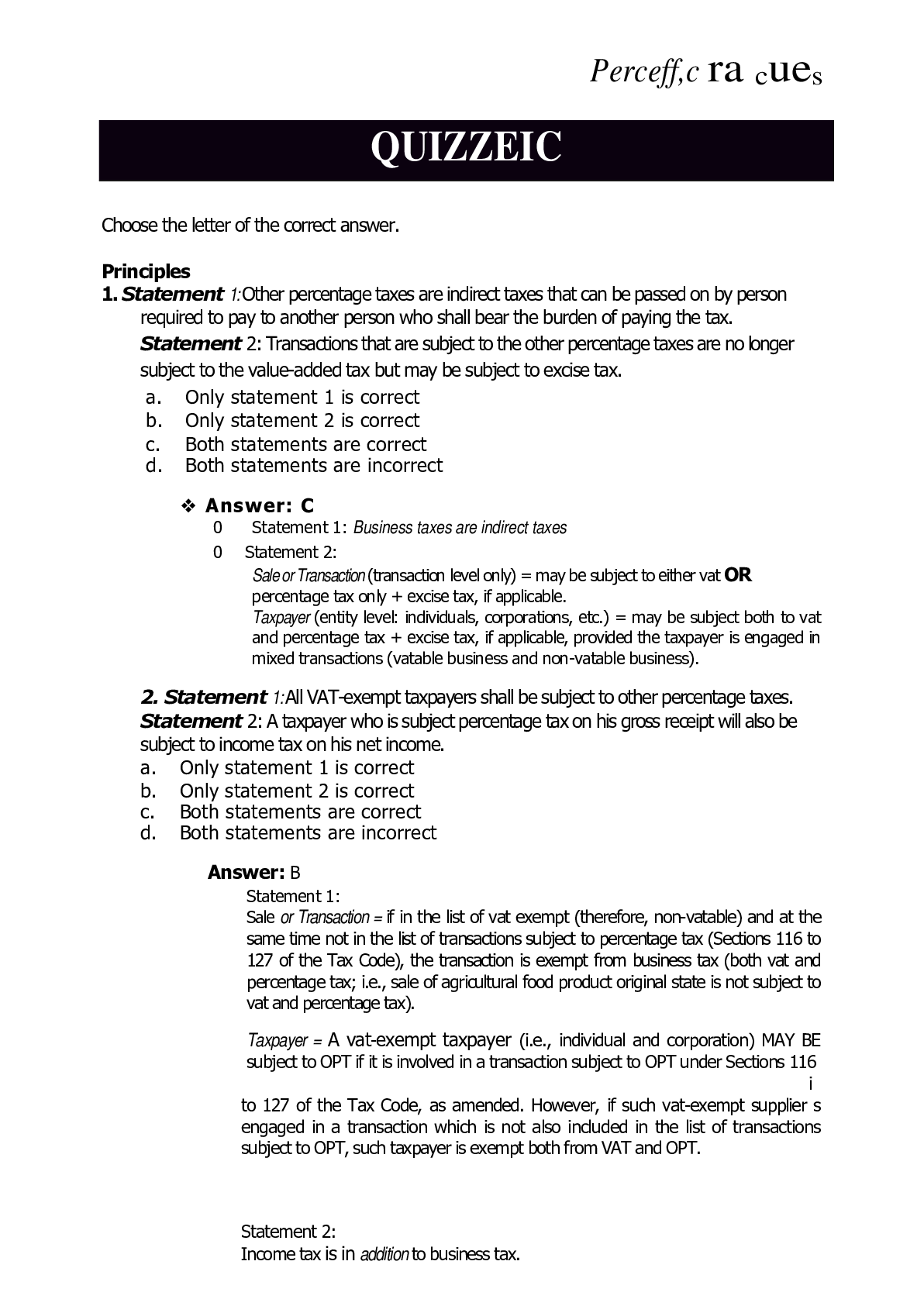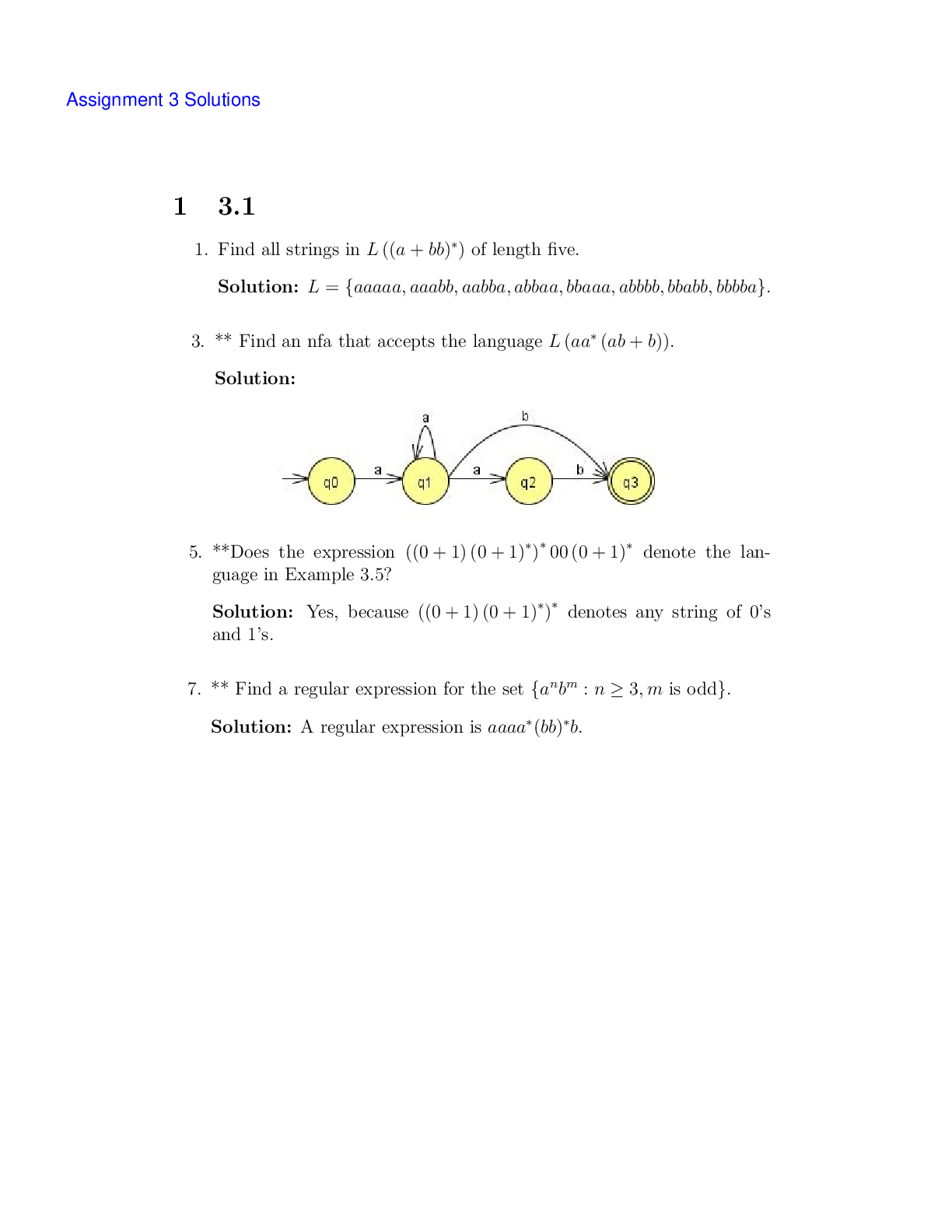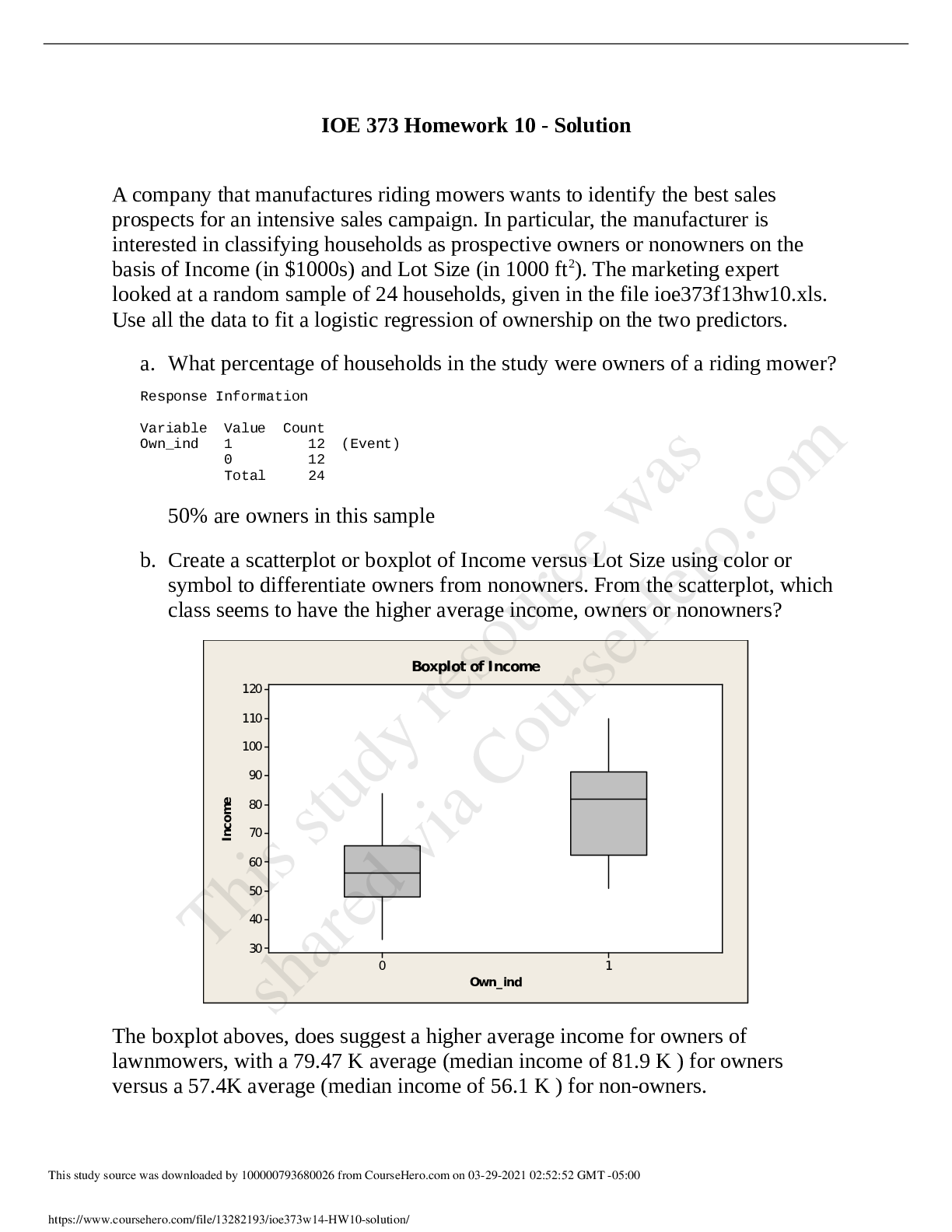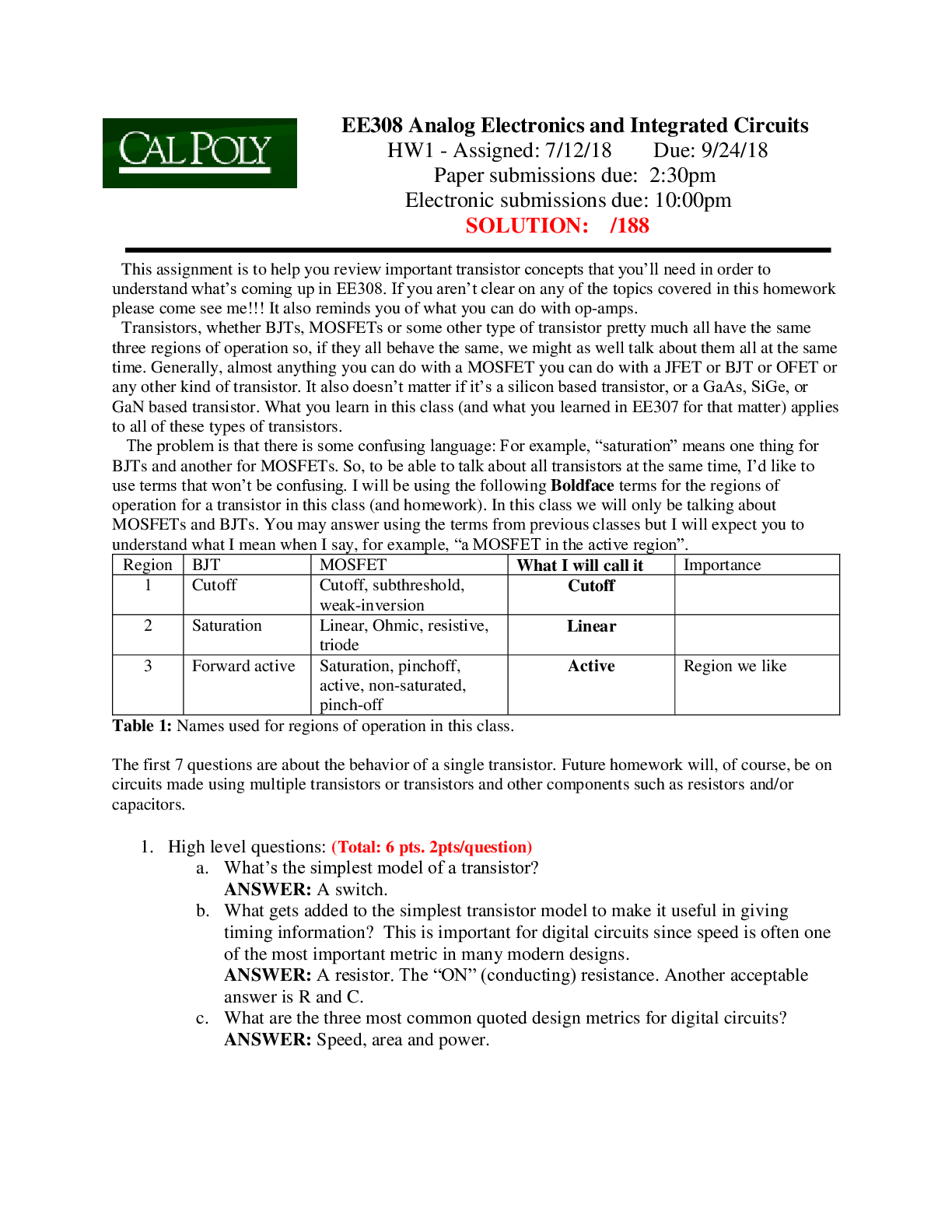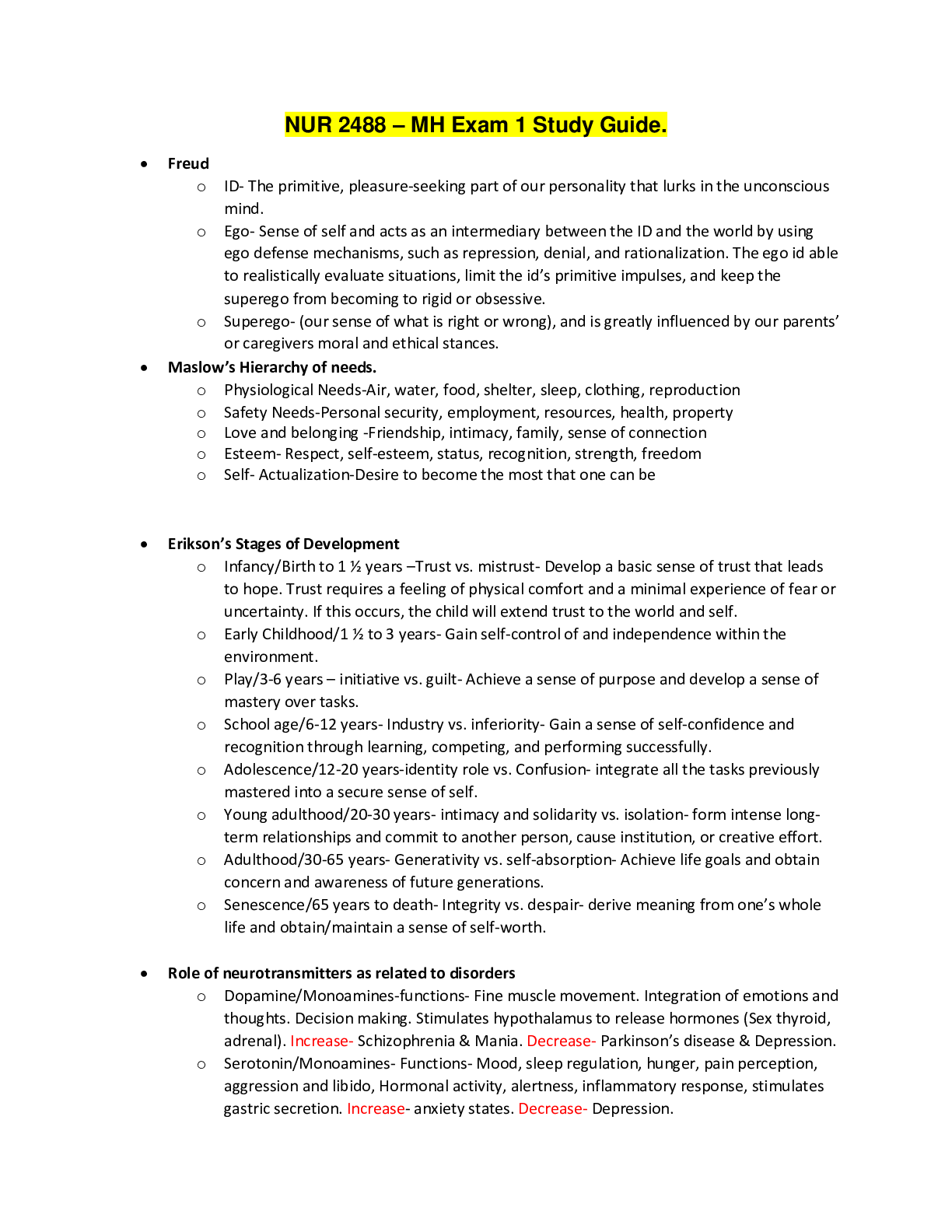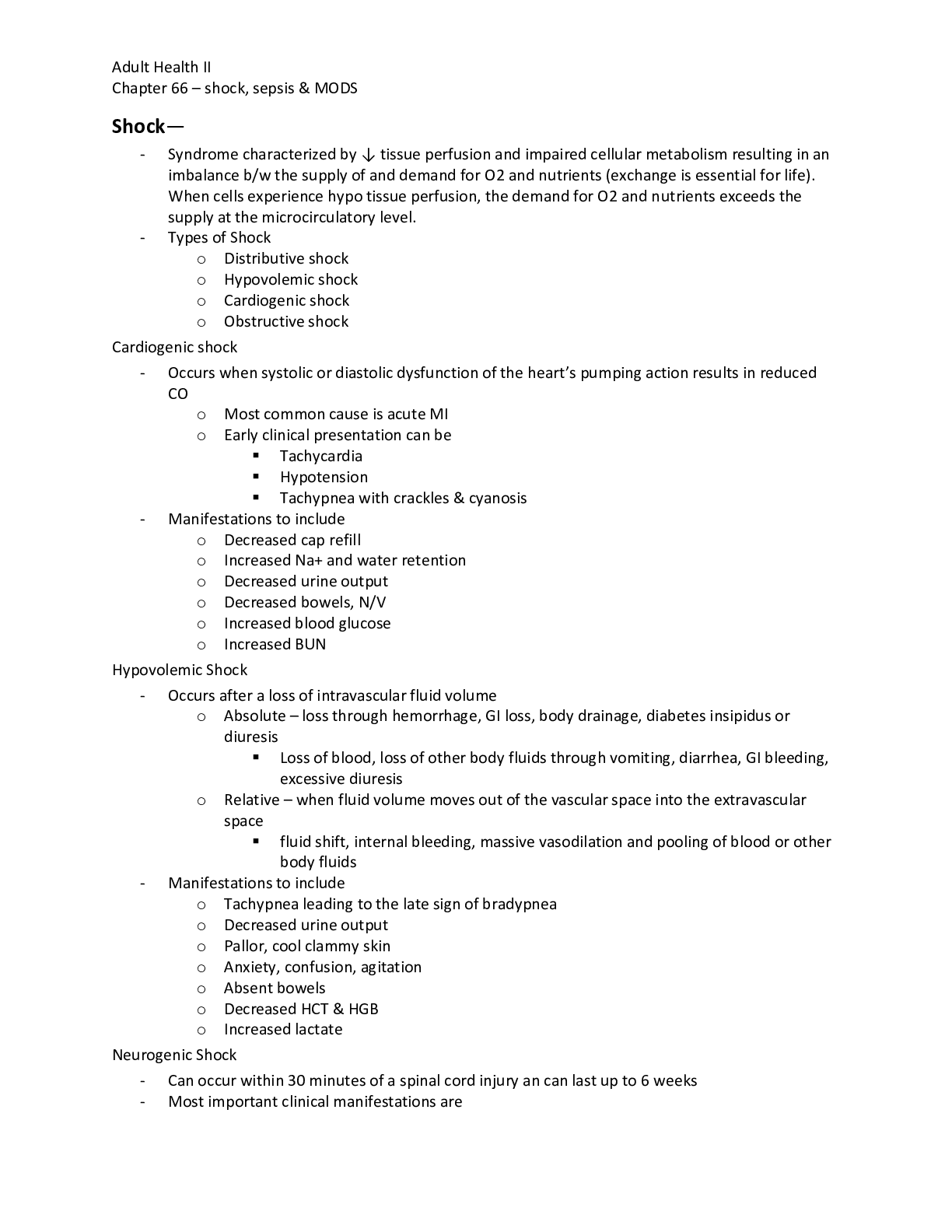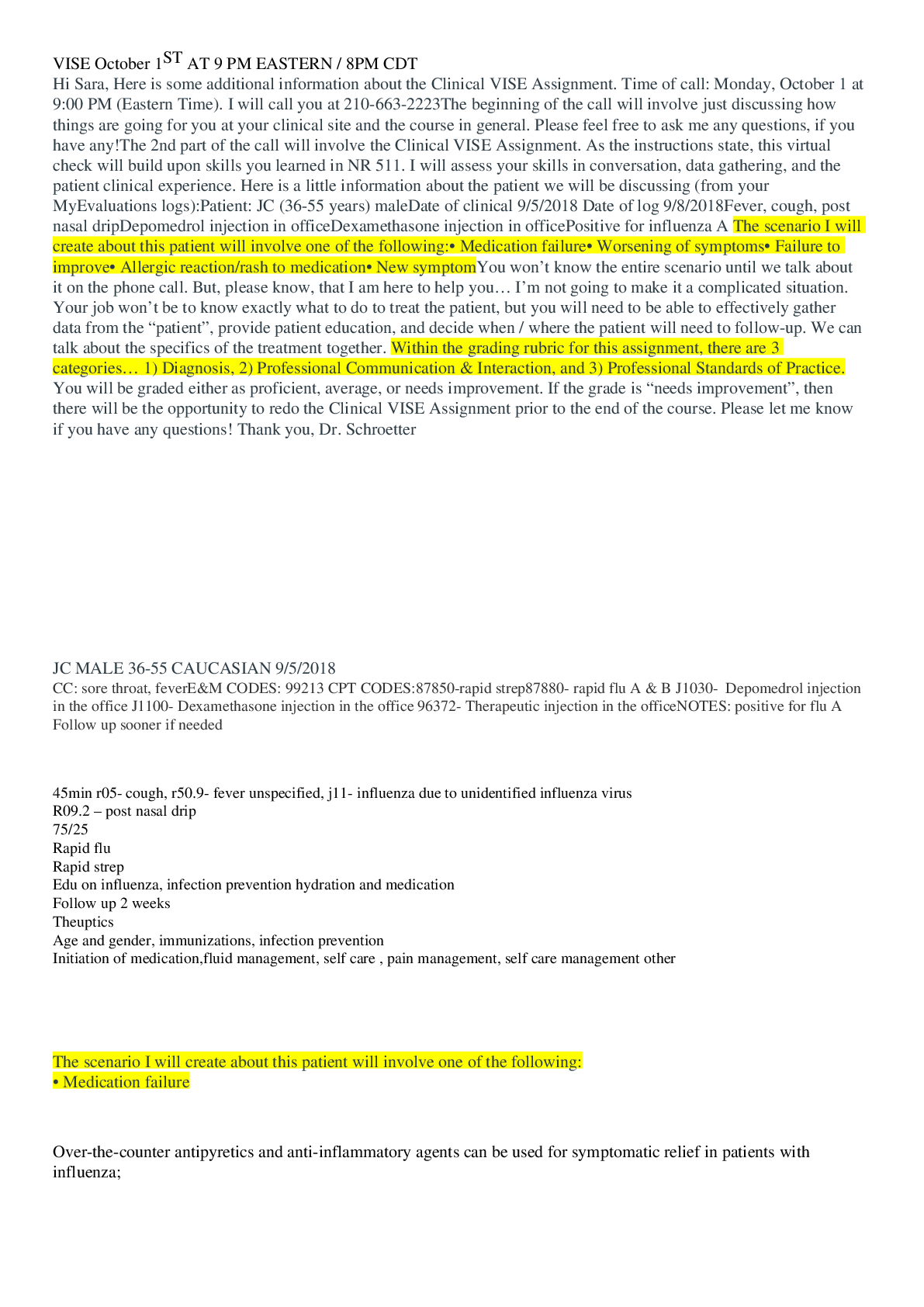*NURSING > Solutions Guide > Essentials-of-Psychiatric-Mental-Health-Nursing-Concepts-of-Care-in-Evidence-Based-Practice-7th-Edit (All)
Essentials-of-Psychiatric-Mental-Health-Nursing-Concepts-of-Care-in-Evidence-Based-Practice-7th-Edition
Document Content and Description Below
Contents in Brief UNIT 1 Chapter 15 SchizophreniaSpectrumand Other Introduction to Psychiatric Mental Psychotic Disorders 340 Health Concepts Chapter 16 Depressive Disorders 377 Mental Health and ... Mental Illness Chapter 17 Bipolar and Related Disorders 418 Chapter 1 2 Biological Implications 14 Chapter 18 Anxiety, Obsessive-Compulsive, and Chapter 2 Related Disorders 446 Chapter 3 Ethical and Legal Issues 39 Chapter 19 Trauma-and Stressor-Related Chapter 4 Psychopharmacology 59 Disorders 477 Chapter 5 Cultural and Spiritual Concepts Chapter 20 Somatic Symptom and Dissociative Relevant to Psychiatric Mental Disorders 503 Health Nursing 94 Chapter 21 Issues Related to Human Sexuality and Gender Dysphoria 530 UNIT2 Chapter 22 Eating Disorders 567 Psychiatric Mental Health Nursing Chapter 23 Personality Disorders 590 Interventions 123 UNIT4 Chapter 6 Relationship Development and Psychiatric Mental Health Nursing Therapeutic Communication 124 of Special Populations 625 Chapter 7 The Nursing Process in Psychiatric Children and Adolescents Mental Health Nursing 146 Chapter 24 626 Milieu Therapy-The Therapeutic Chapter 25 The Aging Individual 668 Chapter 8 Chapter 26 Survivors of Abuse or Neglect 700 Community 171 Chapter 27 Community Mental Health Nursing 722 Chapter 9 Intervention in Groups 182 Chapter 28 The Bereaved Individual 756 Chapter 10 Crisis Intervention 193 Chapter 29 Military Families 777 Chapter 11 The Recovery Model 215 Suicide Prevention Appendix A Assigning NANDA Nursing Diagnosis Chapter 12 228 to Client Behaviors 797 Appendix B Mental Status Assessment 799 UNIT3 Appendix( Glossary 803 Care of Clients With Psychiatric Appendix D Answers to Review Questions 827 Disorders 247 Appendix E Examples of Answers to Communication Exercises 829 Chapter 13 Neurocognitive Disorders 248 AppendixF DSM-5 Classification: Categories and Chapter 14 Substance Use and Addictive Codes 832 Disorders 282 Index 851Contents UNIT 1 Legal Issues in Psychiatric Mental Introduction toPsychiatric Mental Hospitalization Health Nursing 52 47 Health Concepts Nursing Liability 54 Summary and Key Points 55 Chapter 1 Mental Health and Mental Illness 2 Introduction 2 Chapter4 Psychopharmacology 59 Mental Health 3 Introduction 60 Mental Illness 3 Historical Perspectives 60 Physical and Psychological Responses Role of the Nurse 60 to Stress 5 Ethical and Legal Implications 60 Physical Responses 5 Assessment 61 Psychological Responses 6 Medication Administration and Summary and Key Points 11 Evaluation 61 Client Education 63 Chapter 2 Biological Implications 14 How do Psychotropics Work? 63 Introduction 15 Applying the Nursing Process The Nervous System: An Anatomical Review 15 in Psychopharmacological Therapy 64 The Brain 15 Antianxiety Agents 67 Nerve Tissue 19 Antidepressants 68 Autonomic Nervous System 20 Mood-Stabilizing Agents 72 Neurotransmitters 21 Antipsychotic Agents 77 Neuroendocrinology 26 Sedative-Hypnotics 85 Pituitary Gland 26 Agents for Attention Deficit/Hyperactivity Circadian Rhythms 30 Disorder (ADHD) 87 Genetics 30 Summary and Key Points 90 Psychoneuroimmunology (PNI) 31 Cultural and Spiritual Concepts Normal Immune Response 31 Chapter 5 Psychopharmacology and the Brain 34 Relevant to Psychiatric Mental Implications for Nursing 34 Health Nursing 94 Summary and Key Points 35 Cultural Concepts 95 How Do Cultures Differ? 96 Chapter 3 Ethical and Legal Issues 39 Communication 96 Introduction 40 Space 96 Ethical Considerations 41 Social Organization 97 Theoretical Perspectives 41 Time 97 Ethical Dilemmas 42 Environmental Control 97 Ethical Principles 42 Biological Variations 97 A Model for Making Ethical Decisions 43 Application of the Nursing Process 97 Ethical and Legal Issues in Psychiatric Background Assessment Data 97 Mental Health Nursing 43 African Americans 99 Legal Considerations 46 American Indian and Alaska Natives 100 Nurse Practice Ads 46 Asian/Pacific Islander Americans 101 Types of Law 47 Latino Americans 102 Classifications Within Statutory and Arab Americans 103 Common Law 47 Cultural Syndromes 105xxii Contents Planning and Implementation 109 Why Nursing Diagnosis? 157 Evaluation 110 Nursing Case Management 158 Spiritual Concepts 110 Critical Pathways of Care 159 Spiritual Needs 110 Applying the Nursing Process in the Religion 112 Psychiatric Setting 159 Addressing Spiritual and Religious Needs Concept Mapping 161 Through the Nursing Process 113 Documentation of the Nursing Process 162 Assessment 113 Problem-Oriented Recording 162 Diagnoses and Outcome Identification 113 Focus Charting 164 Planning and Implementation 115 The PIE Method 165 Evaluation 115 Electronic Documentation 165 Summary and Key Points 115 Summary and Key Points 167 Chapter 8 Milieu Therapy-The Therapeutic UNIT .2 Community 171 Psychiatric Mental Health Nursing Introduction 171 Interventions 123 Milieu, Defined 172 Current Status of the Therapeutic Chapter6 Relationship Development and Community 172 Basic Assumptions 172 Therapeutic Communication 124 Conditions That Promote a Therapeutic Introduction 125 Community 173 The Therapeutic Nurse-Client Relationship 125 The Program of Therapeutic Community 174 Therapeutic Use of Self 126 The Role of the Nurse in Milieu Therapy 175 Conditions Essential to Development Summary and Key Points 178 of a Therapeutic Relationship 126 Rapport 126 Chapter 9 Intervention in Groups 182 Trust 126 Introduction 183 Respect 127 Functions of a Group 183 Genuineness 127 Types of Groups 183 Empathy 127 Task Groups 183 Phases of a Therapeutic Nurse-Client Teaching Groups 183 Relationship 128 Supportive-Therapeutic Groups 184 The Preinteraction Phase 129 Self-Help Groups 184 The Orientation (Introductory) Phase 129 Physical Conditions That Influence The Working Phase 129 Group Dynamics 184 The Termination Phase 130 Seating 184 Boundaries in the Nurse-Client Relationship 131 Size 185 Interpersonal Communication 132 Membership 185 The Impact of Preexisting Conditions 132 Curative Factors 185 Nonverbal Communication 134 Phases of Group Development 186 Therapeutic Communication Techniques 136 Phase I. Initial or Orientation Phase 186 Nontherapeutic Communication Phase II. Middle or Working Phase 186 Techniques 136 Phase Ill . Final or Termination Phase 186 Active Listening 136 Leadership Styles 187 Process Recordings 138 Autocratic 187 Summary and Key Points 142 Democratic 187 Laissez-Faire 187 Chapter7 The Nursing Process in Psychiatric Member Roles 187 Mental Health Nursing 146 Psychodrama 188 Introduction 147 The Family as a Group 189 The Nursing Process 147 The Role of the Nurse in Therapeutic Definition 147 Groups 189 Standards of Practice 147 Summary and Key Points 190Contents xxiii Chapter 10 Crisis Intervention 193 Epidemiological Factors 229 Introduction 193 Risk Factors 230 Characteristics of a Crisis 194 Marital Status 230 Phases in the Development of a Crisis 194 Gender 230 Types of Crises 195 Age 231 Class T:Dispositional Crises 196 Religion 231 Class 2: Crises of Anticipated Life Socioeconomic Status 231 Transitions 196 Ethnicity 231 Class 3: Crises Resulting from Other Risk Factors 232 Traumatic Stress 196 Predisposing Factors: Theories of Suicide 232 Class 4: Maturational and Psychological Theories 232 Developmental Crises 196 Sociological Theory 233 Class 5: Crises Reflecting Biological Theories 233 Psychopathology 197 Class 6: Psychiatric Emergencies 197 Application of the Nursing Process With the Suicidal Client 233 Crisis on the Inpatient Unit: Anger and Assessment 233 Aggression Management 197 Assessment 197 Diagnosis and Outcome Identification 237 Diagnosis and Outcome Identification 199 Planning and Implementation 237 Evaluation 241 Planning and Implementation 200 Evaluation 200 Summary and Key Points 242 Crisis Intervention 203 UNIT3 Phases of Crisis Intervention: The Role of the Nurse 203 Care of Clients WithPsychiatric Disorders247 Phase T. Assessment 203 Phase 2. Planning of Therapeutic Chapter 13 Neurocognitive Disorders 248 Intervention 204 Introduction 248 Phase 3. Intervention 205 Delirium 249 Phase 4. Evaluation of Crisis Clinical Findings and Course 249 Resolution and Anticipatory Planning 205 Predisposing Factors 249 Disaster Nursing 205 Neurocognitive Disorder 250 Application of the Nursing Process 206 Clinical Findings, Epidemiology, to Disaster Nursing and Course 250 Background Assessment Data 206 Predisposing Factors 253 Nursing Diagnoses and Outcome Application of the Nursing Process 259 Identification 206 Assessment 259 Planning and Implementation 206 Nursing Diagnosis and Outcome Evaluation 206 Identification 262 Summary and Key Points 212 Planning and Implementation 263 Chapter 11 n,e Recovery Model 215 Concept Care Mapping 267 Introduction 215 Client and Family Education 267 Evaluation 267 What Is Recovery? 216 Guiding Principles of Recovery 216 Quality and Safety Education for Nurses (QSEN) 268 Models of Recovery 218 Medical Treatment Modalities 268 The Tidal Model 218 Delirium 268 The Wellness Recovery Action Plan 220 Neurocognitive Disorder (NCO) 268 The Psychological Recovery Model 222 Summary and Key Points 278 Nursing Interventions that Assist with 224 Recovery Chapter 14 Substance Use and Addictive Summary and Key Points 226 Disorders 282 Introduction 283 Chapter 12 Suicide Prevention 228 Introduction 228 Substance Use Disorder, Defined 283 Historical Perspectives 229 Substance Addiction 283xxiv Contents Substance-Induced Disorders, Defined 284 Non-substance Addictions 330 Substance Intoxication 284 Gambling Disorder 330 Substance Withdrawal 284 Summary and Key Points 335 Classes of Psychoactive Substances 284 Predisposing Factors to Substance-Related Chapter 15 Schizophrenia Spedrum and Other Disorders 284 Psychotic Disorders 340 Biological Factors 284 Introduction 341 Psychological Factors 285 Nature of the Disorder 341 Sociocultural Factors 285 Phase I: The Premorbid Phase 342 The Dynamics of Substance-Related Phase II: The Prodromal Phase 342 Disorders 286 Phase Ill: Schizophrenia 342 Alcohol Use Disorder 286 Phase IV: Residual Phase 343 Alcohol Intoxication 291 Prognosis 343 Alcohol Withdrawal 291 Predisposing Factors 343 Sedative, Hypnotic, or Anxiolytic Biological Factors 343 Use Disorder 291 Psychological Factors 346 Sedative, Hypnotic, or Anxiolytic Environmental Influences 346 Intoxication 294 Theoretical Integration 347 Sedative, Hypnotic, or Anxiolytic Types of Schizophrenia and Other Withdrawal 294 Psychotic Disorders 347 Stimulant Use Disorder 294 Delusional Disorder 347 Stimulant Intoxication 298 Brief Psychotic Disorder 348 Stimulant Withdrawal 298 Substance- and Medication-Induced Inhalant Use Disorder 298 Psychotic Disorder 348 Inhalant Intoxication 299 Psychotic Disorder Due to Another Opioid Use Disorder 300 Medical Condition 348 Opioid Intoxication 302 Catatonic Disorder Due to Another Opioid Withdrawal 302 Medical Condition 348 Hallucinogen Use Disorder 302 Schizophreniform Disorder 348 Hallucinogen Intoxication 304 Schizoaffective Disorder 349 Cannabis Use Disorder 305 Application of the Nursing Process 350 Cannabis Intoxication 307 Schizophrenia: Background Cannabis Withdrawal 307 Assessment Data 350 Application of the Nursing Process 307 Diagnosis and Outcome Identification 353 Assessment 307 Planning and Implementation 354 Diagnosis and Outcome Identification 316 Concept Care Mapping 355 Planning and Implementation 317 Evaluation 360 Concept Care Mapping 317 Quality and Safety Education Client and Family Education 321 for Nurses (QSEN) 362 Treatment Modalities for Schizophrenia Evaluation 321 and Other Psychotic Disorders 362 The Chemically Impaired Nurse 322 Psychological Treatments 362 Codependency 323 Social Treatments 366 The Codependent Nurse 324 Organic Treatment 368 Treating Codependency 324 Summary and Key Points 373 Treatment Modalities for Substance-Related Disorders 325 Chapter 16 Depressive Disorders 377 Alcoholics Anonymous 325 Introduction 378 Pharmacotherapy 325 Historical Perspective 378 Counseling 328 Epidemiology 378 Group Therapy 328 Age and Gender 379 Psychopharmacology for Substance Social Class 379 Intoxication and Substance Race and Culture 379 Withdrawal 328Contents XXV Marital Status 379 Predisposing Factors 422 Seasonality 379 Biological Theories 422 Types of Depressive Disorders 380 Psychosocial Theories 423 Major Depressive Disorder 380 The Transactional Model of Stress Persistent Depressive Disorder and Adaptation 423 (Dysthymia) 382 Developmental Implications 424 Premenstrual Dysphoric Disorder 382 Childhood and Adolescence 424 Substance- or Medication-Induced Application of the Nursing Process Depressive Disorder 382 to Bipolar Disorder (Mania) 425 Depressive Disorder Due to Another Background Assessment Data 425 Medical Condition 382 Diagnosis and Outcome Identification 426 Predisposing Factors 382 Planning and Implementation 427 Biological Theories 383 Concept Care Mapping 427 Psychosocial Theories 387 Client and Family Education 427 Developmental Implications 388 Evaluation of Care for the Client Childhood 388 Experiencing a Manic Episode 430 Adolescence 390 Treatment Modalities for Bipolar Senescence 390 Disorder (Mania) 432 Postpartum Depression 391 Individual Psychotherapy 432 Application of the Nursing Process 392 Group Therapy 432 Background Assessment Data 392 Family Therapy 433 Diagnosis and Outcome Identification 395 Cognitive Therapy 433 Planning and Implementation 395 The Recovery Model 433 Concept Care Mapping 395 Electroconvulsive Therapy 434 Client and Family Education 401 Psychopharmacology With Evaluation of Care for the Depressed Mood-Stabilizing Agents 434 Client 401 Summary and Key Points 442 Quality and Safety Education for Nurses (QSEN) 401 Chapter 18 Anxiety, Obsessive-Compulsive, Treatment Modalities for Depression 403 and Related Disorders 446 Individual Psychotherapy 403 Introduction 447 Group Therapy 403 Historical Aspects 447 Cognitive Therapy 405 Epidemiological Statistics 449 Electroconvulsive Therapy 405 How Much Is Too Much? 449 Transcranial Magnetic Stimulation 406 Application of the Nursing ProcessVagal Nerve Stimulation and Deep Assessment 449 Brain Stimulation 407 Panic Disorder 449 Light Therapy 407 Generalized Anxiety Disorder 450 Psychopharmacology 408 Phobias 451 Summary and Key Points 414 Anxiety Disorder Due to Another Medical Condition and SubstanceChapter 17 Bipolar and Related Disorders 418 or Medication-Induced Anxiety Introduction 419 Disorder 455 Historical Perspective 419 Obsessive-Compulsive Disorder 455 Epidemiology 419 Body Dysmorphic Disorder 456 Types of Bipolar Disorders 419 Trichotillomania (Hair-Pulling Disorder) 457 Bipolar I Disorder 420 Hoarding Disorder 457 Bipolar II Disorder 420 Assessment Scales 459 Cyclothymic Disorder 420 Diagnosis and Outcome Identification 459 Substance- and Medication-Induced Outcome Criteria 459 Bipolar Disorder 421 Planning and Implementation 460 Bipolar Disorder Due to Another Concept Care Mapping 460 Medical Condition 421 Client and Family Education 465xxvi Contents Evaluation 465 Diagnosis and Outcome Identification 513 Treatment Modalities 467 Planning and Implementation 514 Individual Psychotherapy 467 Concept Care Mapping 521 Cognitive Therapy 467 Evaluation 521 Behavior Therapy 468 Treatment Modalities 521 Psychopharmacology 469 Somatic Symptom Disorders 521 Summary and Key Points 474 Dissociative Amnesia 524 Trauma-and Stressor-Related Dissociative Identity Disorder 524 Chapter 19 Depersonalization-Derealization Disorders 477 Disorder 524 Introduction 478 Summary and Key Points 527 Historical and Epidemiological Data 478 Application of the Nursing Process- Chapter 21 Issues Relatedto Human Sexuality Trauma-Related Disorders 479 and Gender Dysphoria 530 Posttraumatic Stress Disorder and Introduction 531 Acute Stress Disorder 479 Development of Human Sexuality 531 Theories of Etiology related to Birth Through Age 12 531 Trauma-Related Disorders 479 Adolescence 532 Trauma-Informed Care 482 Adulthood 533 Diagnosis and Outcome Identification 483 Sexual Disorders 534 Planning and Implementation 483 Historical Aspects 534 Concept Care Mapping 483 Paraphilic Disorders 534 Evaluation 483 Sexual Dysfunctions 538 Application of the Nursing Process- Application of the Nursing Process to Stressor-Related Disorders 486 Sexual Disorders 541 Adjustment Disorders-Background Assessment 541 Assessment Data 486 Diagnosis and Outcome Identification Theories of Etiology Related to 544 Adjustment Disorders 491 Planning and Implementation 545 Diagnosis and Outcome Identification 491 Concept Care Mapping 545 Planning and Implementation 492 Client and Family Education 548 Concept Care Mapping 494 Evaluation 548 Evaluation 494 Quality and Safety Education Treatment Modalities 494 for Nurses (QSEN) 548 Treatment Modalities for Sexual Trauma-Related Disorders 494 Dysfunctions 548 Adjustment Disorders 497 Gender Dysphoria 552 Summary and Key Points 500 Course and Epidemiology 552 Chapter 20 Somatic Symptom and Dissociative Predisposing Factors 552 Disorders 503 Application of the Nursing Process to Introduction 504 Gender Dysphoria in Children 553 Background Assessment Data Historical Aspects 504 (Symptomatology) 553 Epidemiological Statistics 505 Diagnosis and Outcome Identification 553 Application of the Nursing Process 506 Planning and Implementation 554 Background Assessment Data: Evaluation 554 Types of Somatic Symptom Treatment Issues 556 Disorders 506 Predisposing Factors Associated With Gender Dysphoria in Adolescents Somatic Symptom and Related or Adults 556 Disorders 509 Treatment Issues 556 Background Assessment Data: Variations in Sexual Orientation 558 Types of Dissociative Disorders 510 Homosexuality 559 Predisposing Factors Associated With Bisexuality 561 Dissociative Disorders 512 Summary and Key Points 563Contents xxvii Chapter 22 Eating Disorders 567 Treatment Modalities 615 Introduction 568 Individual Psychotherapy 617 Epidemiological Factors 568 Milieu or Group Therapy 617 Application of the Nursing Process 569 Cognitive Behavior Therapy 617 Background Assessment Data: Dialectical Behavior Therapy 617 Anorexia Nervosa 569 Psychopharmacology 618 Background Assessment Data: Summary and Key Points 621 Bulimia Nervosa 569 Background Assessment Data: UNIT4 Binge Eating Disorder 570 Background Assessment Data: Psychiatric Mental Health Nursing Body Mass Index 572 of Special Populations 625 Diagnosis and Outcome Identification 572 Planning and Implementation 574 Chapter 24 Children and Adolescents 626 Concept Care Mapping 579 Introduction 627 Client and Family Education 582 Neurodevelopmental Disorders 627 Evaluation 582 Intellectual Disability (Intellectual Quality and Safety Education Developmental Disorder) 627 for Nurses (QSEN) 583 Autism Spectrum Disorder 631 Treatment Modalities 583 Attention Deficit/Hyperactivity Disorder 636 Behavior Modification 584 Tourette's Disorder 645 Individual Therapy 584 Disruptive Behavior Disorders 649 Family Treatment: Oppositional Defiant Disorder 649 The Maudsley Approach 584 Conduct Disorder 653 Psychopharmacology 584 Anxiety Disorders 657 Summary and Key Points 587 Separation Anxiety Disorder 657 Chapter 23 Personality Disorders 590 Quality and Safety Education Introduction 591 for Nurses (QSEN) 659 Historical Aspects 591 General Therapeutic Approaches 661 Types of Personality Disorders 593 Behavior Therapy 661 Paranoid Personality Disorder 593 Family Therapy 662 Schizoid Personality Disorder 594 Group Therapy 662 Schizotypal Personality Disorder 595 Psychopharmacology 662 Antisocial Personality Disorder 596 Summary and Key Points 664 BPD 596 Chapter 25 TheAgingIndividual 668 Histrionic Personality Disorder 596 Introduction 669 Narcissistic Personality Disorder 597 How Old Is Old? 669 Avoidant Personality Disorder 598 Epidemiological Statistics 670 Dependent Personality Disorder 599 The Population 670 Obsessive-Compulsive Personality Marital Status 670 Disorder 599 Living Arrangements 670 Application of the Nursing Process 601 Economic Status 670 BPD (Background Assessment Data) 601 Employment 671 Diagnosis and Outcome Identification 604 Health Status 671 Planning and Implementation 604 Theories of Aging 671 Concept Care Mapping 604 Biological Theories 671 Evaluation 604 Psychosocial Theories 672 Antisocial Personality Disorder (Background Assessment Data) 610 The Normal Aging Process 674 Diagnosis and Outcome Identification 612 Biological Aspects of Aging 674 Planning and Implementation 613 Psychological Aspects of Aging 676 Concept Care Mapping 615 Sociocultural Aspects of Aging 679 Evaluation 615 Sexual Aspects of Aging 680xxviii Contents Special Concerns of the Elderly Population 681 Application of the Nursing Process 764 Retirement 681 Background Assessment Data: long-Term Care 683 Concepts of Death-Developmental Issues 764 Elder Abuse 684 Suicide 686 Background Assessment Data: Concepts of Death-Cultural Issues 765 Application of the Nursing Process 686 Nursing Diagnosis and Outcome Assessment 686 Identification 767 Diagnosis and Outcome Identification 687 Planning and Implementation 768 Planning and Implementation 688 Evaluation 768 Evaluation 688 Additional Assistance 770 Summary and Key Points 696 Hospice 770 Chapter 26 Suavivorsof Abuse or Negled 700 Advance Directives 771 Introduction 701 Summary and Key Points 773 Predisposing Factors 701 Chapter 29 Military Families 777 Biological Theories 702 Historical Aspects 778 Psychological Theories 702 Epidemiological Statistics 778 Sociocultural Theories 702 Application of the Nursing Process 778 Application of the Nursing Process 704 Assessment 778 Background Assessment Data 704 Diagnosis and Outcome Identification 786 Diagnosis and Outcome Identification 711 Planning, Implementation, Planning and Implementation 712 and Evaluation 786 Concept Care Mapping 712 Treatment Modalities 790 Evaluation 714 Posttraumatic Stress Disorder 790 Treatment Modalities 715 Traumatic Brain Injury 792 Crisis Intervention 715 Summary and Key Points 792 The Safe House or Shelter 716 Family Therapy 716 Appendix A Assigning NANDA Nursing Diagnosis Summary and Key Points 718 to Client Behaviors 797 Chapter 27 Community Mental Health Nursing 722 Appendix B Mental Status Assessment 799 Introduction 723 Appendix C Glossary 803 The Changing Focus of Care 723 Appendix D Answers to Review Questions 827 The Public Health Model 724 Appendix E Examples of Answers to Communication The Community as Client 726 Exercises 829 Primary Prevention 726 DSM-5 Classification: categories and Secondary Prevention 731 Appendix F Codes 832 Tertiary Prevention 735 Summary and Key Points 752 Index 851 Chapter 28 n,e BereavedIndividual 756 Introduction 757 Theoretical Perspectives on Loss and Bereavement 757 Stages of Grief 757 Length of the Grief Process 761 Anticipatory Grief 762 Maladaptive Responses to Loss 762 Delayed or Inhibited Grief 762 Distorted (Exaggerated) Grief Response 762 Chronic or Prolonged Grieving 763 Normal versus Maladaptive Grieving 763 [Show More]
Last updated: 2 years ago
Preview 1 out of 952 pages
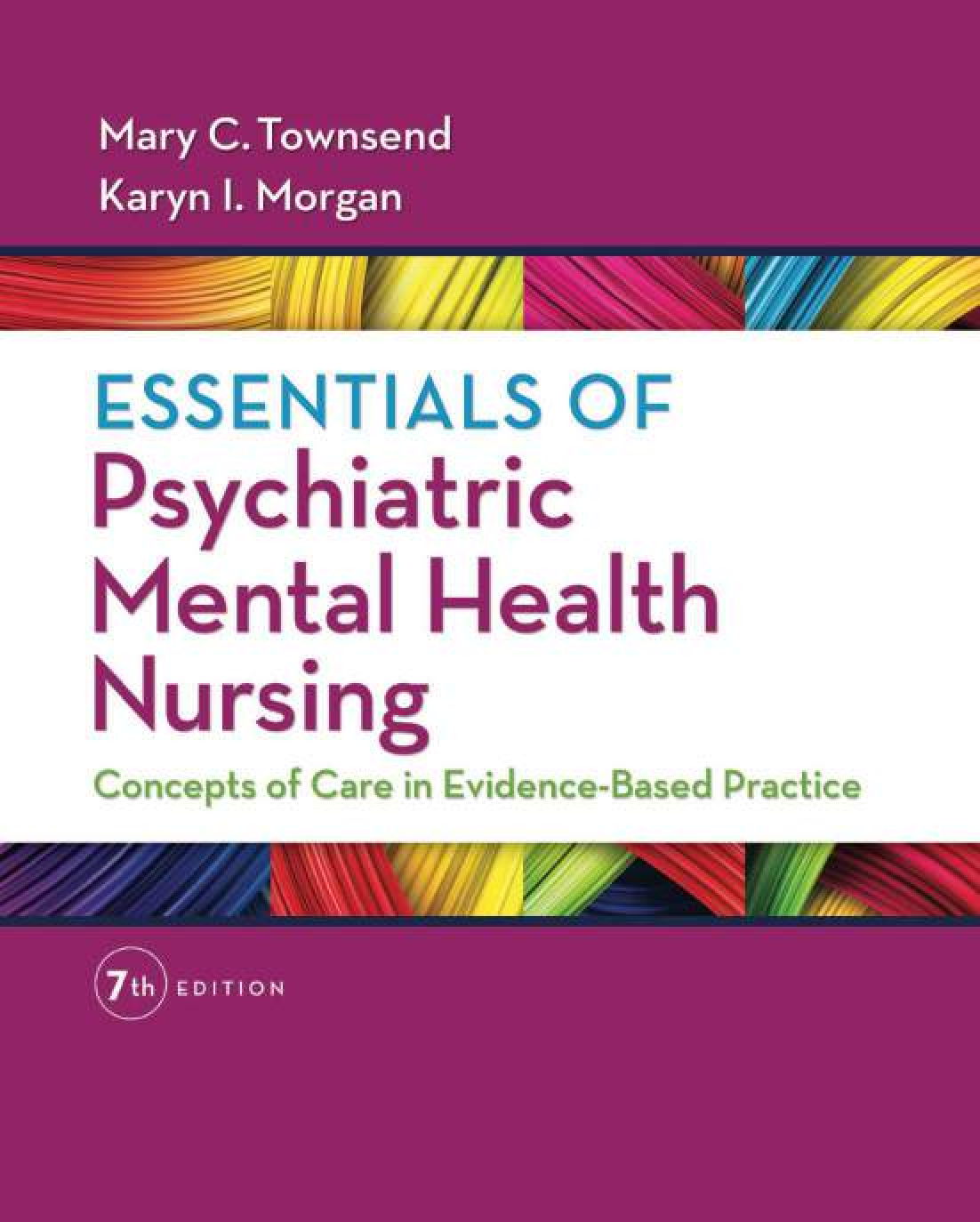
Buy this document to get the full access instantly
Instant Download Access after purchase
Buy NowInstant download
We Accept:

Reviews( 0 )
$15.00
Can't find what you want? Try our AI powered Search
Document information
Connected school, study & course
About the document
Uploaded On
Jul 16, 2021
Number of pages
952
Written in
Additional information
This document has been written for:
Uploaded
Jul 16, 2021
Downloads
0
Views
117

